Romanians
The Romanians (Romanian: români, pronounced [roˈmɨnʲ]) are a Romance[53][54][55][56] ethnic group and nation native to Romania, that share a common Romanian culture, ancestry, and speak the Romanian language, the most widespread spoken Balkan Romance language, which is descended from the Latin language. According to the 2011 Romanian census, just under 89% of Romania's citizens identified themselves as ethnic Romanians.
 | |||||||||||||||||||||||||||||||||||||||||||||||||||||||||||||
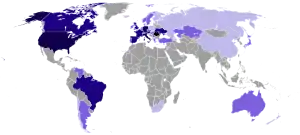 Ethnic distribution of Romanians around the world | |||||||||||||||||||||||||||||||||||||||||||||||||||||||||||||
| Total population | |||||||||||||||||||||||||||||||||||||||||||||||||||||||||||||
|---|---|---|---|---|---|---|---|---|---|---|---|---|---|---|---|---|---|---|---|---|---|---|---|---|---|---|---|---|---|---|---|---|---|---|---|---|---|---|---|---|---|---|---|---|---|---|---|---|---|---|---|---|---|---|---|---|---|---|---|---|---|
| c. 24—30 million[1][2][3] (Including Moldovans as a subgroup, which is a matter of ethnic and linguistic scholarly debate) | |||||||||||||||||||||||||||||||||||||||||||||||||||||||||||||
| Regions with significant populations | |||||||||||||||||||||||||||||||||||||||||||||||||||||||||||||
(additional 2,068,058 Moldovans)[5][6] | |||||||||||||||||||||||||||||||||||||||||||||||||||||||||||||
| Other countries | |||||||||||||||||||||||||||||||||||||||||||||||||||||||||||||
| |||||||||||||||||||||||||||||||||||||||||||||||||||||||||||||
| |||||||||||||||||||||||||||||||||||||||||||||||||||||||||||||
| |||||||||||||||||||||||||||||||||||||||||||||||||||||||||||||
| |||||||||||||||||||||||||||||||||||||||||||||||||||||||||||||
| |||||||||||||||||||||||||||||||||||||||||||||||||||||||||||||
| Languages | |||||||||||||||||||||||||||||||||||||||||||||||||||||||||||||
| Romanian | |||||||||||||||||||||||||||||||||||||||||||||||||||||||||||||
| Religion | |||||||||||||||||||||||||||||||||||||||||||||||||||||||||||||
| Predominantly † Orthodox Christianity (Romanian Orthodox Church), also Roman Catholic, Greek Catholic, and Protestant | |||||||||||||||||||||||||||||||||||||||||||||||||||||||||||||
| Related ethnic groups | |||||||||||||||||||||||||||||||||||||||||||||||||||||||||||||
| Other Romance-speaking peoples; (most notably Vlachs, Moldovans, Aromanians, Megleno-Romanians, and Istro-Romanians) | |||||||||||||||||||||||||||||||||||||||||||||||||||||||||||||
1 The number of the citizens of Romania is indicated in the countries Italy, Spain, Germany, Portugal, Greece, Cyprus, the Netherlands, Ireland, the Czech Republic and Turkey, and the number of the citizens of Moldova in the additional figure in the same countries. | |||||||||||||||||||||||||||||||||||||||||||||||||||||||||||||
In one interpretation of the census results in Moldova, the Moldovans are counted as Romanians, which would mean that the latter form part of the majority in that country as well.[57][58] Romanians are also an ethnic minority in several nearby countries situated in Central, respectively Eastern Europe, particularly in Hungary, Czech Republic, Ukraine (including Moldovans), Serbia, and Bulgaria.
Today, estimates of the number of Romanian people worldwide vary from 26 to 30 million according to various sources, evidently depending on the definition of the term 'Romanian', Romanians native to Romania and Republic of Moldova and their afferent diasporas, native speakers of Romanian, as well as other Balkan Romance-speaking groups considered by most scholars and the Romanian Academy[59] as a constituent part of the broader Romanian people, specifically Aromanians, Megleno-Romanians, Istro-Romanians, and Vlachs of Serbia (including medieval Vlachs), in Croatia, in Bulgaria, or in Bosnia and Herzegovina.[1][2][3][60][61]
History
Antiquity
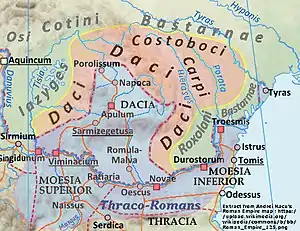
Inhabited by the ancient Dacians, part of today's territory of Romania was conquered by the Roman Empire in 106,[62] when Trajan's army defeated the army of Dacia's ruler Decebalus (see Dacian Wars). The Roman administration withdrew two centuries later, under the pressure of the Goths and Carpi.
Two theories account for the origin of the Romanian people. One, known as the Daco-Roman continuity theory, posits that they are descendants of Romans and Romanized indigenous peoples living in the Roman Province of Dacia, while the other posits that the Romanians are descendants of Romans and Romanized indigenous populations of the former Roman provinces of Illyricum, Moesia, Thracia, and Macedonia, and the ancestors of Romanians later migrated from these Roman provinces south of the Danube into the area which they inhabit today.
According to the first theory, the Romanians are descended from indigenous populations that inhabited what is now Romania and its immediate environs: Thracians (Dacians, Getae) and Roman legionnaires and colonists. In the course of the two wars with the Roman legions, between AD 101–102 and AD 105–106 respectively, the emperor Trajan succeeded in defeating the Dacians and the greatest part of Dacia became a Roman province.
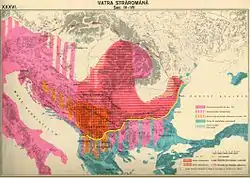
The colonisation with Roman or Romanized elements, the use of the Latin language and the assimilation of Roman civilisation as well as the intense development of urban centres led to the Romanization of part of the autochthonous population in Dacia. This process was probably concluded by the 10th century when the assimilation of the Slavs by the Daco-Romanians was completed.[63]
According to the south-of-the-Danube origin theory, the Romanians' ancestors, a combination of Romans and Romanized peoples of Illyria, Moesia and Thrace, moved northward across the Danube river into modern-day Romania. Small population groups speaking several versions of Romanian (Megleno-Romanian, Istro-Romanian, and Aromanian) still exist south of the Danube in Greece, Albania, Macedonia, Bulgaria and Serbia, but it is not known whether they themselves migrated from more northern parts of the Balkans, including Dacia. The south-of-the Danube theory usually favours northern Albania and/or Moesia (modern day Serbia and Northern Bulgaria) as the more specific places of Romanian ethnogenesis.
Small genetic differences were reportedly[64] found among Southeast European (Greece, Albania) populations and especially those of the Dniester–Carpathian (Romania, Moldova, Ukraine) region. Despite this low level of differentiation between them, tree reconstruction and principal component analyses allowed a distinction between Balkan–Carpathian (Romanians, Moldovans, Ukrainians, Macedonians, and Gagauzes) and Balkan Mediterranean (Greeks, Albanians, Turks) population groups. The genetic affinities among Dniester–Carpathian and southeastern European populations do not reflect their linguistic relationships. According to the report, the results indicate that the ethnic and genetic differentiations occurred in these regions to a considerable extent independently of each other.
Middle Ages to Early Modern Age
During the Middle Ages Romanians were mostly known as Vlachs, a blanket term ultimately of Germanic origin, from the word Walha, used by ancient Germanic peoples to refer to Romance-speaking and Celtic neighbours. Besides the separation of some groups (Aromanians, Megleno-Romanians, and Istro-Romanians) during the Age of Migration, many Vlachs could be found all over the Balkans, in Transylvania,[65] across Carpathian Mountains[66] as far north as Poland and as far west as the regions of Moravia (part of the modern Czech Republic), some went as far east as Volhynia of western Ukraine, and the present-day Croatia where the Morlachs gradually disappeared, while the Catholic and Orthodox Vlachs took Croat and Serb national identity.[67]
Because of the migrations that followed – such as those of Slavs, Bulgars, Hungarians, and Tatars – the Romanians were organised in agricultural communes (obști), developing large centralised states only in the 14th century, when the Danubian Principalities of Moldavia and Wallachia emerged to fight the Ottoman Empire.

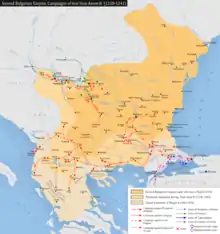
During the Middle Ages the Bulgarian Empire controlled vast areas to the north of the river Danube (with interruptions) from its establishment in 681 to its fragmentation in 1371–1422. These lands were called by contemporary Byzantine historians Bulgaria across the Danube, or Transdanubian Bulgaria.[68] Original information for the centuries-old Bulgarian rule there is scarce as the archives of the Bulgarian rulers were destroyed and little is mentioned for this area in Byzantine or Hungarian manuscripts. During the First Bulgarian Empire, the Dridu culture developed in the beginning of the 8th century and flourished until the 11th century.[69][70] It represents an early medieval archaeological culture which emerged in the region of the Lower Danube.[69][70] In Bulgaria it is usually referred to as Pliska-Preslav culture.[71]
During the late Middle Ages, prominent medieval Romanian monarchs such as Bogdan of Moldavia, Stephen the Great, Mircea the Elder, Michael the Brave, or Vlad the Impaler took part actively in the history of Central Europe by waging tumultuous wars and leading noteworthy crusades against the then continuously expanding Ottoman Empire, at times allied with either the Kingdom of Poland or the Kingdom of Hungary in these causes.
Eventually the entire Balkan peninsula was annexed by the Ottoman Empire. However, Moldavia and Wallachia (extending to Dobruja and Bulgaria) were not entirely subdued by the Ottomans as both principalities became autonomous (which was not the case of other Ottoman territorial possessions in Europe). Transylvania, a third region inhabited by an important majority of Romanian speakers, was a vassal state of the Ottomans until 1687, when the principality became part of the Habsburg possessions. The three principalities were united for several months in 1600 under the authority of Wallachian Prince Michael the Brave.[72]

Additionally, in medieval times there were other lands known by the name 'Vlach' (such as Great Vlachia, situated between Thessaly and the western Pindus mountains, originally within the Byzantine Empire, but after the 13th century autonomous or semi-independent; White Wallachia, a Byzantine denomination for the region between the Danube River and the Balkans; Moravian Wallachia, a region in south-eastern Czech Republic).
Up until 1541, Transylvania was part of the Kingdom of Hungary, later (due to the conquest of Hungary by the Ottoman Empire) was a self-governed Principality governed by the Hungarian nobility. In 1699 it became a part of the Habsburg lands. By the 19th century, the Austrian Empire was awarded by the Ottomans with the region of Bukovina and, in 1812, the Russians occupied the eastern half of Moldavia, known as Bessarabia.
Late Modern Age to Contemporary Era
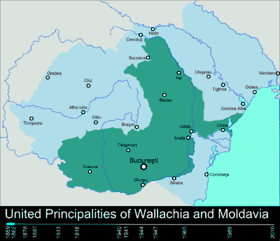
_in_Hungary%252C_census_1890.jpg.webp)
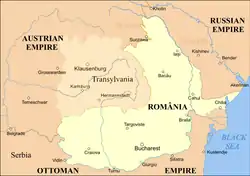
In the context of the 1848 Romanticist and liberal revolutions across Europe, the events that took place in the Grand Principality of Transylvania were the first of their kind to unfold in the Romanian-speaking territories. On the one hand, the Transylvanian Saxons and the Transylvanian Romanians (with consistent support on behalf of the Austrian Empire) successfully managed to oppose the goals of the Hungarian Revolution of 1848, with the two noteworthy historical figures leading the common Romanian-Saxon side at the time being Avram Iancu and Stephan Ludwig Roth.
On the other hand, the Wallachian revolutions of 1821 and 1848 as well as the Moldavian Revolution of 1848, which aimed for independence from Ottoman and Russian foreign rulership, represented important impacts in the process of spreading the liberal ideology in the eastern and southern Romanian lands, in spite of the fact that all three eventually failed. Nonetheless, in 1859, Moldavia and Wallachia elected the same ruler, namely Alexander John Cuza (who reigned as Domnitor) and were thus unified de facto, resulting in the United Romanian Principalities for the period between 1859 and 1881.
During the 1870s, the United Romanian Principalities (then led by Hohenzollern-Sigmaringen Domnitor Carol I) fought a War of Independence against the Ottomans, with Romania's independence being formally recognised in 1878 at the Treaty of Berlin. Although the newly founded Kingdom of Romania initially allied with Austria-Hungary, Romania refused to enter World War I on the side of the Central Powers, because it was obliged to wage war only if Austria-Hungary was attacked. In 1916, Romania joined the war on the side of the Triple Entente.
As a result, at the end of the war, Transylvania, Bessarabia, and Bukovina were awarded to Romania, through a series of international peace treaties, resulting in an enlarged and far more powerful kingdom under King Ferdinand I. As of 1920, the Romanian people was believed to number over 15 million solely in the region of the Romanian kingdom, a figure larger than the populations of Sweden, Denmark, and the Netherlands combined.[73]
During the interwar period, two additional monarchs came to the Romanian throne, namely Carol II and Michael I. This short-lived period was marked, at times, by political instabilities and efforts of maintaining a constitutional monarchy in favour of other, totalitarian regimes such as an absolute monarchy or a military dictatorship.
During World War II, the Kingdom of Romania lost territory both to the east and west, as Northern Transylvania became part of Hungary through the Second Vienna Award, while Bessarabia and northern Bukovina were taken by the Soviets and included in the Moldavian SSR, respectively Ukrainian SSR. The eastern territory losses were facilitated by the Molotov-Ribbentrop Nazi-Soviet non-aggression pact.
After the end of the war, the Romanian Kingdom managed to regain territories lost westward but was nonetheless not given Bessarabia and northern Bukovina, the aforementioned regions being forcefully incorporated into the Soviet Union. Subsequently, the Soviet Union imposed a Communist government and King Michael was forced to abdicate and leave for exile. Nicolae Ceaușescu became the head of the Romanian Communist Party in 1965 and his severe rule of the 1980s was ended by the Romanian Revolution of 1989.
The 1989 revolution brought to power the dissident communist Ion Iliescu (backed by the FSN). He remained in power as head of state until 1996, when he was defeated by CDR-supported Emil Constantinescu at the 1996 general elections, the first in post-Communist Romania that saw a peaceful transition of power. Following Constantinescu's only term as president from 1996 to 2000, Iliescu was re-elected in late 2000 for another term of four years. In 2004, Traian Băsescu, the PNL-PD candidate, was elected president. Five years later, Băsescu was narrowly re-elected for a second term at the 2009 presidential elections.
In 2014, the PNL-PDL candidate Klaus Iohannis won a surprise victory over former prime minister and PSD-supported contender Victor Ponta in the second round of the 2014 presidential elections. Thus, Iohannis became the first Romanian president stemming from an ethnic minority (as he belongs to the Romanian-German community, being a Transylvanian Saxon). In 2019, the PNL-supported Iohannis was re-elected for a second term as president at the 2019 Romanian presidential election.
In the meantime, Romania's major foreign policy achievements were the alignment with Western Europe and the United States by joining the North Atlantic Treaty Organization (NATO) in 2004 and the European Union three years later, in 2007.
Genetics
The prevailing element in Wallachia (Ploiești, Dolj), Moldavia (Piatra Neamț, Buhuși), Dobruja (Constanța), and northern Republic of Moldova is recorded to be Haplogroup I,[74] while the gene pool of Transylvania is often untypical and diverse.[75]
On the basis of 361 samples, Haplogroup I occurs at 32% in Romanians.[76] The highest frequency of I2a1 (I-P37) in the Balkans today was present before the Slavic expansion and is owed to indigenous tribes,[77] and is particularly suggested to have been common among the ancient Thracians in Romania.[78]
According to 335 sampled Romanians, 15% of them belong to R1a.[79] Haplogroup R1a among Romanians is entirely from the Eastern European variety Z282 and may be a result of Baltic, Thracian or Slavic descent. R1a-Z280 outnumbers R1a-M458 among Romanians, the opposite phenomena is typical for Poles, Czechs and Bulgarians. 12% of the Romanians belong to R1b, the Alpino-Italic branch R1b-U152 is at 2% per 330 samples, a lower frequency recorded than other Balkan peoples.[80]
The branches R1b-U106, R1b-DF27 and R1b-L21 make up 1% respectively.[80] The eastern branches R1b-M269* and L23* (Z2103) make up 7% and outnumber the Atlantic branches, they prevail in parts of east, central Europe and as a result of Greek colonisation – in parts of Sicily as well.[80] 8% of the Romanians belong to E1b1b1a1 (E-M78) per 265 samples.[81]
From a group of 178 males from 9 Romanian counties, mainly from Transylvania, most of them belong to the Paleolithic European lineage I2a (17% I2a1b, 2% I2a2, 3% I2*), to R1a (20%) and to E1b1b1a1b (19%).[75] Haplogroup J2 is represented at 16% among them, unlike the structure in the Apennine Peninsula, among Romanians the J2b clade prevails.[75] About 10% of these belong to Haplogroup R1b in all counties. R1b-U152, the specific Alpino-Italic clade, is represented at 3% among them, the prevailing branches are eastern, except for Brașov where Germanic U106 is most frequent. U106 is also prevalent clade of R1b in Buhuși and Piatra Neamț. In Brașov and Dolj I2 prevails, in Cluj – R1a. Another 6% of these belong to I1 and 2% to G2a. T, N, Q are also represented by frequencies of less than a percent.[75]
Despite negligible Roman genetic traits in general, one early study[82] of 219 Romanians found strong indications in other parts of Transylvania, in the region corresponding to Roman Dacia. The highest frequency of R1b (31–32%) in Eastern Europe only behind Trebic in the Czech Republic (32.7%) was found in the Romanian counties Arad and Alba, that experienced Celtic settlement, the heaviest and only Roman colonisation with a significant number of colonists from Noricum and West Pannonia, and later German settlement.
The subclade of R1b was not revealed in the case, but no similar high or prevailing frequency of Eastern subclades of R1b has ever been found in Europe. Three of the ten towns that were almost exclusively populated by Roman citizens (Apulum, Ampelum and Potaissa) were in present Alba Iulia county, not far from the Roman capital Sarmizegetusa. Genetic isolate due to migration from unattested migration from the Middle East would not be a plausible historic-geographical event as even the eastern branch of R1b in Europe is different than these in the Middle East. The only ethnic groups with higher frequencies of R1b in the East are the Aromanians due to their main ancestry from the Roman West. In some occasions the U106 branch, which is minimal among Romanians, rises to the prevailing clade in some cities, but still at a low frequency. The high frequency of R1b was found in other places in Transylvania – 25% in Maramureș and Harghita, 20% in Mehedinți, 14% in Bihor, 11% in Vrancea, 0% in Neamț. Excluding Arad and Alba Iulia, Haplogroup I+G was found as most frequent in all, except Maramureș, where Haplogroup J was found to be prevalent.
According to an autosomal analysis of eastern Europeans and adjacent peoples, the group of Bulgarians and Macedonians is located together with Romanians.[77] Most West Slavs, Hungarians, and Austrians tend to share as many identical by-descent segments with South Slavs as with Romanians, Torbeshi and Gagauzes.[77]
Showing the importance of geography, a 2017 paper, concentrating on the mtDNA, signalling how Romania has been "a major crossroads between Asia and Europe" and thus "experienced continuous migration and invasion episodes", while precising that "previous studies" show Romanians "exhibit genetic similarity with other Europeans" or that "another study pointed to possible segregation within the Middle East populations", also mentions how "signals of Asian maternal lineages were observed in all Romanian historical provinces, indicating gene flow along the migration routes through East Asia and Europe, during different time periods, namely, the Upper Paleolithic period and/or, with a likely greater preponderance, the Middle Ages", and concludes that "our current findings based on the mtDNA analysis of populations in historical provinces of Romania suggest similarity between populations in Transylvania and Central Europe," on one hand, as well between Wallachia, Moldavia, and Dobrudja with the Balkans, on the another, "supported both by the observed clines in haplogroup frequencies for several European and Asian maternal lineages and MDS analyses."[83]
Language
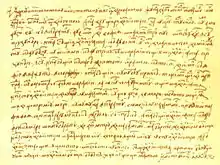
The origins of the Romanian language, a Romance language, can be traced back to the Roman colonisation of the region. The basic vocabulary is of Latin origin,[73] although there are some substratum words that are sometimes assumed to be of Dacian origin.
During the Middle Ages, Romanian was isolated from the other Romance languages, and borrowed words from the nearby Slavic languages (see Slavic influence on Romanian). Later on, it borrowed a number of words from German, Hungarian, and Turkish.[84] During the modern era, most neologisms were borrowed from French and Italian, though the language has increasingly begun to adopt English borrowings.
The Moldovan language, in its official form, is practically identical to Romanian, although there are some differences in colloquial speech. In the de facto independent (but internationally unrecognised) region of Transnistria, the official script used to write Moldovan is Cyrillic.
Since 2013, the Romanian Language Day is celebrated on 31 August in Romania. A similar holiday also exists in Moldova on the same day since 1990. It is known as "Limba noastră".[85][86]
As of 2017, an Ethnologue estimation puts the (worldwide) number of Romanian speakers at approximately 24.15 million.[87] The 24.15 million, however, represent only speakers of Romanian, not all of whom are necessarily ethnic Romanians. Also, this number does not include ethnic-Romanians who no longer speak the Romanian language.
Surnames
Many Romanian surnames have the suffix -escu or (less commonly) -așcu or -ăscu which corresponds to the Latin suffix -iscus and means "belonging to the people". For example, Petrescu used to be Petre's kin. Similar suffixes such as -asco, -asgo, -esque, -ez, etc. are present in other Latin-derived languages. Many Romanians in France changed this ending of their surnames to -esco, because the way it is pronounced in French better approximates the Romanian pronunciation of -escu.
Another widespread suffix of Romanian surnames is -eanu (or -an, -anu), which indicates the geographical origin. Here some examples: Moldoveanu/Moldovan/Moldovanu, from the region of Moldavia or from river Moldova, Munteanu "from mountains", Jianu "from Jiu river region", Pruteanu, meaning from the Prut river, Mureșanu, meaning from the Mureș river, Petreanu (meaning the son of Petre) etc..
Other suffixes are -aru (or -oru, -ar, -or), which indicates an occupation (like Feraru "smith", Morar "miller"), and -ei, usually preceded by A- in front of a female name, which is a Latin inherited female genitive, like in Amariei "of Maria", Aelenei "of Elena". These matrilineal-rooted surnames are common in the historical region of Moldavia.
Names for Romanians
In English, Romanians are usually called Romanians, Rumanians, or Roumanians except in some historical texts, where they are called Roumans or Vlachs.
Etymology of the name Romanian (român)

From the Middle Ages, Romanians bore two names, the exonym (one given to them by foreigners) Wallachians or Vlachs, under its various forms (vlah, valah, valach, voloh, blac, olăh, vlas, ilac, ulah, etc.), and the endonym (the name they used for themselves) Romanians (Rumâni/Români).[89]
The name "Romanian" is derived from Latin "Romanus". Under regular phonetical changes that are typical to the Romanian languages, the name romanus over the centuries transformed into "rumân" [ruˈmɨn]. An older form of "român" was still in use in some regions. Socio-linguistic evolutions in the late 18th century led to a gradual preponderance of the "român" spelling form, which was then generalised during the National awakening of Romania of early 19th century.
Until the 19th century, the term Romanian denoted the speakers of the Daco-Romanian dialect of the Romanian language, thus being a much more distinct concept than that of Romania, the country of the Romanians. Prior to 1867, the (Daco-)Romanians were part of different state entities: with the Moldavians and the Wallachians being split off and having shaped separate political identities, possessing states of their own, while the rest of the Romanians were part of other states. However, eventually they retained their Romanian cultural and ethnic identity up today.
Daco-Romanian
To distinguish Romanians from the other Romanic peoples of the Balkans (Aromanians, Megleno-Romanians, and Istro-Romanians), the term Daco-Romanian is sometimes used to refer to those who speak the standard Romanian language and live in the territory of ancient Dacia (today comprising mostly Romania and Moldova), although some Daco-Romanians can be found in the eastern part of Central Serbia (which was part of ancient Moesia).
Etymology of the term Vlach
The name of "Vlachs" is an exonym that was used by Slavs to refer to all Romanized natives of the Balkans. It holds its origin from ancient Germanic—being a cognate to "Welsh" and "Walloon"—and perhaps even further back in time, from the Roman name Volcae, which was originally a Celtic tribe. From the Slavs, it was passed on to other peoples, such as the Hungarians (Oláh) and Greeks (Vlachoi) (see the Etymology section of Vlachs). Wallachia, the Southern region of Romania, takes its name from the same source.
Nowadays, the term Vlach is more often used to refer to the Romanized populations of the Balkans who speak Daco-Romanian, Aromanian, Istro-Romanian, and Megleno-Romanian.
Anthroponyms
These are family names that have been derived from either Vlach or Romanian. Most of these names have been given when a Romanian settled in a non-Romanian region. Examples: Oláh (37,147 Hungarians have this name), Vlach, Vlahuta, Vlasa, Vlasi, Vlašic, Vlasceanu, Vlachopoulos, Voloh, Volyh, Vlack, Flack, and Vlax.
Romanians outside Romania
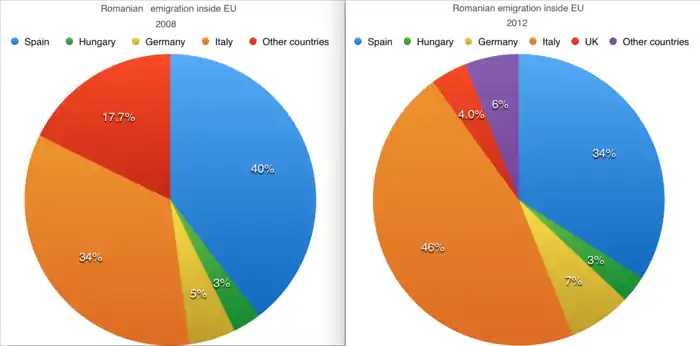
Most Romanians live in Romania, where they constitute a majority; Romanians also constitute a minority in the countries that neighbour Romania. Romanians can also be found in many countries, notably in the other EU countries, particularly in Italy, Spain, Germany, the United Kingdom and France; in North America in the United States and Canada; in Israel; as well as in Brazil, Australia, Argentina, and New Zealand among many other countries. Italy and Spain have been popular emigration destinations, due to a relatively low language barrier, and both are each now home to about a million Romanians. With respect to geopolitical identity, many individuals of Romanian ethnicity in Moldova prefer to identify themselves as Moldovans.[57][58]
The contemporary total population of ethnic Romanians cannot be stated with any degree of certainty. A disparity can be observed between official sources (such as census counts) where they exist, and estimates which come from non-official sources and interested groups. Several inhibiting factors (not unique to this particular case) contribute towards this uncertainty, which may include:
- A degree of overlap may exist or be shared between Romanian and other ethnic identities in certain situations, and census or survey respondents may elect to identify with one particular ancestry but not another, or instead identify with multiple ancestries;[90]
- Counts and estimates may inconsistently distinguish between Romanian nationality and Romanian ethnicity (i.e. not all Romanian nationals identify with Romanian ethnicity, and vice versa);[90]
- The measurements and methodologies employed by governments to enumerate and describe the ethnicity and ancestry of their citizens vary from country to country. Thus the census definition of "Romanian" might variously mean Romanian-born, of Romanian parentage, or also include other ethnic identities as Romanian which otherwise are identified separately in other contexts;[90]
For example, the decennial US Census of 2000 calculated (based on a statistical sampling of household data) that there were 367,310 respondents indicating Romanian ancestry (roughly 0.1% of the total population).[91]
The actual total recorded number of foreign-born Romanians was only 136,000 Migration Information Source However, some non-specialist organisations have produced estimates which are considerably higher: a 2002 study by the Romanian-American Network Inc. mentions an estimated figure of 1,200,000[43] for the number of Romanian-Americans. Which makes the United States home to the largest Romanian community outside Romania.
This estimate notes however that "...other immigrants of Romanian national minority groups have been included such as: Armenians, Germans, Gypsies, Hungarians, Jews, and Ukrainians". It also includes an unspecified allowance for second- and third-generation Romanians, and an indeterminate number living in Canada. An error range for the estimate is not provided. For the United States 2000 Census figures, almost 20% of the total population did not classify or report an ancestry, and the census is also subject to undercounting, an incomplete (67%) response rate, and sampling error in general.
Culture
Contributions to contemporary culture
Romanians have played and contributed a major role in the advancement of the arts, culture, sciences, technology and engineering.
In the history of aviation, Traian Vuia and Aurel Vlaicu built and tested some of the earliest aircraft designs, while Henri Coandă discovered the Coandă effect of fluidics. Victor Babeș discovered more than 50 germs and a cure for a disease named after him, babesiosis; biologist Nicolae Paulescu discovered insulin. Another biologist, Emil Palade, received the Nobel Prize for his contributions to cell biology. George Constantinescu created the theory of sonics, while mathematician Ștefan Odobleja is regarded as the ideological father behind cybernetics – his work The Consonantist Psychology (Paris, 1938) was the main source of inspiration for N. Wiener's Cybernetics (Paris, 1948). Lazăr Edeleanu was the first chemist to synthesize amphetamine and also invented the modern method of refining crude oil.
 Aurel Vlaicu, early pioneer of spacecraft and aviation
Aurel Vlaicu, early pioneer of spacecraft and aviation Traian Vuia, early pioneer of spacecraft and aviation
Traian Vuia, early pioneer of spacecraft and aviation Petrache Poenaru, the inventor of the modern pen
Petrache Poenaru, the inventor of the modern pen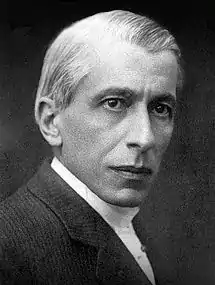 Nicolae Paulescu, a pioneer of insulin development
Nicolae Paulescu, a pioneer of insulin development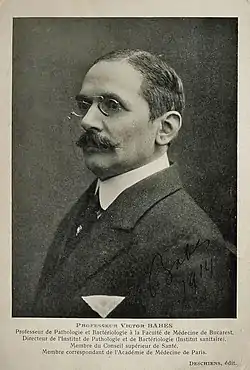 Victor Babeș, physician and bacteriologist who made early progress in studying several diseases
Victor Babeș, physician and bacteriologist who made early progress in studying several diseases Emil Racoviță, the first biologist to study Arctic life
Emil Racoviță, the first biologist to study Arctic life
In the arts and culture, prominent figures were George Enescu (music composer, violinist, professor of Sir Yehudi Menuhin), Constantin Brâncuși (sculptor), Eugène Ionesco (playwright), Mircea Eliade (historian of religion and novelist), Emil Cioran (essayist, Prix de l'Institut Francais for stylism) and Angela Gheorghiu (soprano). More recently, filmmakers such as Cristi Puiu and Cristian Mungiu have attracted international acclaim, as has fashion designer Ioana Ciolacu.
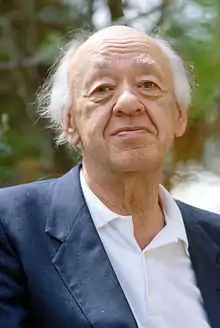 Eugen Ionescu, famous playwright
Eugen Ionescu, famous playwright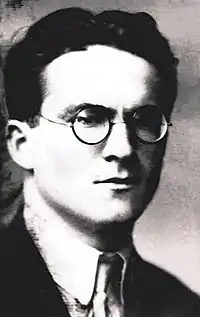 Mircea Eliade, writer and historian of religions
Mircea Eliade, writer and historian of religions Emil Cioran, essayist and philosopher
Emil Cioran, essayist and philosopher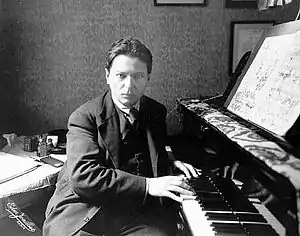 George Enescu, renowned music composer
George Enescu, renowned music composer Sergiu Celibidache, honored conductor and music teacher
Sergiu Celibidache, honored conductor and music teacher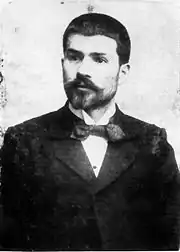 Constantin Brâncuși, reputed sculptor
Constantin Brâncuși, reputed sculptor
In sports, Romanians have excelled in a variety of fields, such as football (Gheorghe Hagi), gymnastics (Nadia Comăneci, Lavinia Miloșovici etc.), tennis (Ilie Năstase, Ion Țiriac, Simona Halep), rowing (Ivan Patzaichin) and handball (four times men's World Cup winners). Count Dracula is a worldwide icon of Romania. This character was created by the Irish fiction writer Bram Stoker, based on some stories spread in the late Middle Ages by the frustrated German trademen of Kronstadt (Brașov) and on some vampire folk tales about the historic Romanian figure of Prince Vlad Țepeș.
Religion
Almost 90% of all Romanians consider themselves religious.[92] The vast majority are Eastern Orthodox Christians, belonging to the Romanian Orthodox Church (a branch of Eastern Orthodoxy, or Eastern Orthodox Church, together with the Greek Orthodox, Orthodox Church of Georgia and Russian Orthodox Churches, among others). Romanians form the third largest ethno-linguistic group among Eastern Orthodox in the world.[93][94]
According to the 2011 census, 93.6% of ethnic Romanians in Romania identified themselves as Romanian Orthodox (in comparison to 81% of Romania's total population, including other ethnic groups).[95] However, the actual rate of church attendance is significantly lower and many Romanians are only nominally believers. For example, according to a 2006 Eurobarometer poll, only 23% of Romanians attend church once a week or more.[96] A 2006 poll conducted by the Open Society Foundation found that only 33% of Romanians attended church once a month or more.[97]
 Romano-Gothic Densuș Church, Hunedoara, Transylvania
Romano-Gothic Densuș Church, Hunedoara, Transylvania.jpg.webp) Romano-Gothic Strei Church, Hunedoara, Transylvania
Romano-Gothic Strei Church, Hunedoara, Transylvania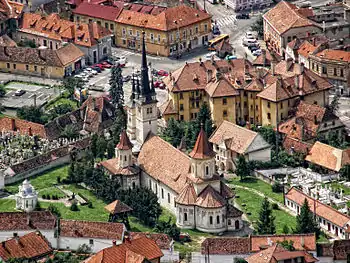 St. Nicholas Church, Brașov, Transylvania
St. Nicholas Church, Brașov, Transylvania Nativity of St. John the Baptist Church, Piatra Neamț, Moldavia
Nativity of St. John the Baptist Church, Piatra Neamț, Moldavia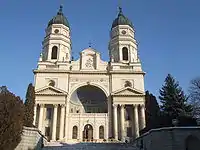 Metropolitan Cathedral, Iași, Moldavia
Metropolitan Cathedral, Iași, Moldavia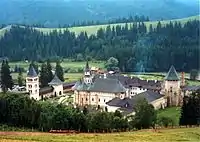 Putna Monastery, Bukovina
Putna Monastery, Bukovina
Romanian Catholics are present in Transylvania, Banat, Bukovina, Bucharest, and parts of Moldavia, belonging to both the Roman Catholic Church (297,246 members) and the Romanian Greek-Catholic Catholic Church (124,563 members). According to the 2011 census, 2.5% of ethnic Romanians in Romania identified themselves as Catholic (in comparison to 5% of Romania's total population, including other ethnic groups). Around 1.6% of ethnic Romanians in Romania identify themselves as Pentecostal, with the population numbering 276,678 members. Smaller percentages are Protestant, Jews, Muslims, agnostic, atheist, or practice a traditional religion.
.jpg.webp) Roman Catholic Saint Joseph Cathedral, Bucharest, Wallachia
Roman Catholic Saint Joseph Cathedral, Bucharest, Wallachia Roman Catholic St. Michael's Cathedral, Alba Iulia, Transylvania
Roman Catholic St. Michael's Cathedral, Alba Iulia, Transylvania.jpg.webp) Greek Catholic Holy Trinity Cathedral, Blaj, Transylvania
Greek Catholic Holy Trinity Cathedral, Blaj, Transylvania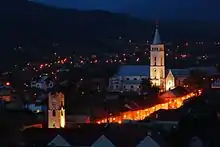 Greek Catholic Assumption of Mary Cathedral, Baia Mare, Transylvania
Greek Catholic Assumption of Mary Cathedral, Baia Mare, Transylvania Roman Catholic St. John of Nepomuk Church, Suceava, Bukovina
Roman Catholic St. John of Nepomuk Church, Suceava, Bukovina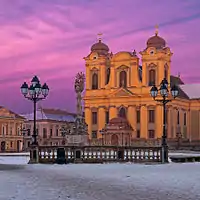 Roman Catholic St. George's Cathedral in Timișoara, Banat
Roman Catholic St. George's Cathedral in Timișoara, Banat
There are no official dates for the adoption of religions by the Romanians. Based on linguistic and archaeological findings, historians suggest that the Romanians' ancestors acquired polytheistic religions in the Roman era, later adopting Christianity, certainly by the 4th century CE when decreed by Emperor Constantine as the official religion of the Roman Empire. Like in all other Romance languages, the basic Romanian words related to Christianity are inherited from Latin, such as God ("Dumnezeu" < Domine Deus), church ("biserică" < basilica), cross ("cruce" < crux, -cis), angel ("înger" < angelus), saint (regional: "sfân(t)" < sanctus), Christmas ("Crăciun" < creatio, -onis), Christian ("creștin" < christianus), Easter ("paște" < paschae), sin ("păcat" < peccatum), to baptise ("a boteza" < batizare), priest ("preot" < presbiterum), to pray ("a ruga" < rogare), faith ( "credință" < credentia ), and so on.
After the Great Schism, there existed a Catholic Bishopric of Cumania (later, separate bishoprics in both Wallachia and Moldavia). However, this seems to be the exception, rather than the rule, as in both Wallachia and Moldavia the state religion was Eastern Orthodox. Until the 17th century, the official language of the liturgy was Old Church Slavonic. Then, it gradually changed to Romanian.
According to a survey that took place in 2011, despite 94% of respondents answered positively for believing in God, 42% support the vision of Christian dogma that there is a God incarnated into a human being. While 34% of respondents said that there is only one true religion, 38% believe that there is one true religion and that other religions contain some basic truths, according to 18% there is one true religion and all major world religions contain some fundamental truths. 88% of Romanians believe in the existence of a soul, 87% believe in sin and the existence of heaven, 60% believe in an "evil eye", 25% believe in horoscopes and 23% in aliens.[98] According to a 2004 survey, 80% consider themselves not superstitious and the same amount believe in angels, about 40% believe they have had dreams that became deja vu and 19% believe in ghosts.[99]
Symbols

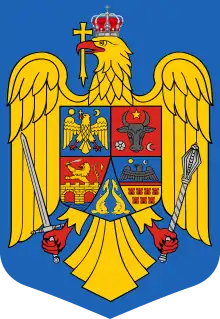
In addition to the colours of the Romanian flag, each historical province of Romania has its own characteristic symbol:
- Banat: Trajan's Bridge
- Dobruja: Dolphin
- Moldavia (including Bukovina and Bessarabia): Aurochs/Wisent
- Oltenia: Lion
- Transylvania (including Crișana and Maramureș): Black eagle or Turul
- Wallachia: Eagle
The coat of arms of Romania combines these together.
Customs
Relationship to other ethnic groups
The closest ethnic groups to the Romanians are the other Romanic peoples of Southeastern Europe: the Aromanians (Macedo-Romanians), the Megleno-Romanians, and the Istro-Romanians. The Istro-Romanians are the closest ethnic group to the Romanians, and it is believed they left Maramureș, Transylvania about a thousand years ago and settled in Istria, Croatia.[100] Numbering about 500 people still living in the original villages of Istria while the majority left for other countries after World War II (mainly to Italy, United States, Canada, Germany, France, Sweden, Switzerland, Romania, and Australia), they speak the Istro-Romanian language, the closest living relative of Romanian.
The Aromanians and the Megleno-Romanians are Romanic peoples who live south of the Danube, mainly in Greece, Albania, North Macedonia and Bulgaria although some of them migrated to Romania in the 20th century. It is believed that they diverged from the Romanians in the 7th to 9th century, and currently speak the Aromanian language and Megleno-Romanian language, both of which are Balkan Romance languages, like Romanian, and are sometimes considered by traditional Romanian linguists to be dialects of Romanian.
Gallery
 Transylvanian Romanian peasants from Abrud
Transylvanian Romanian peasants from Abrud Romanian family going to a fair, early 19th century
Romanian family going to a fair, early 19th century Traditional Romanian peasant costume (first group)
Traditional Romanian peasant costume (first group)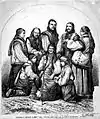 Romanians from Transylvania, late 19th century
Romanians from Transylvania, late 19th century Romanian peasant costume from Bukovina, early 20th century
Romanian peasant costume from Bukovina, early 20th century Romanians from Bukovina, early 20th century postcard
Romanians from Bukovina, early 20th century postcard Romanians from Wallachia, early 19th century
Romanians from Wallachia, early 19th century_%C5%BDdrelo.JPG.webp) Romanians from central Serbia, late 19th century
Romanians from central Serbia, late 19th century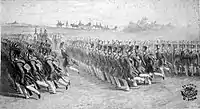 Romanian infantrymen from Wallachia, early 19th century
Romanian infantrymen from Wallachia, early 19th century Romanian immigrants in New York City, late 19th century
Romanian immigrants in New York City, late 19th century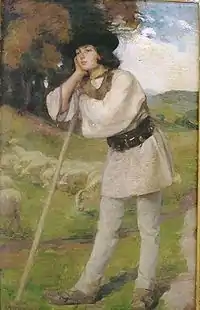 Young Wallachian shepherd, early 20th century
Young Wallachian shepherd, early 20th century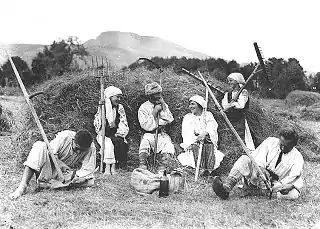 Romanian peasants during the harvest season (1920)
Romanian peasants during the harvest season (1920)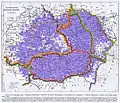 Mid 19th century French map depicting Romanians in Central and Eastern Europe
Mid 19th century French map depicting Romanians in Central and Eastern Europe Early 20th century ethnic distribution of Eastern Romance-speaking groups (including, most notably, the Romanians)
Early 20th century ethnic distribution of Eastern Romance-speaking groups (including, most notably, the Romanians).jpg.webp) Romanians in Central Europe (coloured in blue), 1880
Romanians in Central Europe (coloured in blue), 1880.jpg.webp) Ethnic map of Austria-Hungary and Romania, 1892
Ethnic map of Austria-Hungary and Romania, 1892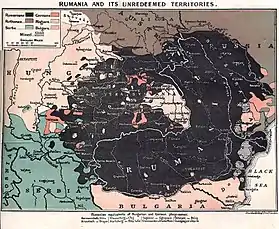 British map depicting territories inhabited by Eastern Romance peoples before the outbreak of World War I
British map depicting territories inhabited by Eastern Romance peoples before the outbreak of World War I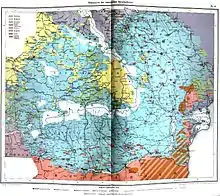 Romanian speakers in Central and Eastern Europe, early 20th century
Romanian speakers in Central and Eastern Europe, early 20th century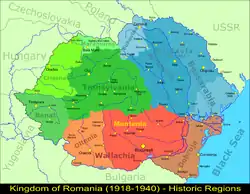 Map of the Kingdom of Romania (1920–1940)
Map of the Kingdom of Romania (1920–1940) Geographic distribution of ethnic Romanians in the early 21st century
Geographic distribution of ethnic Romanians in the early 21st century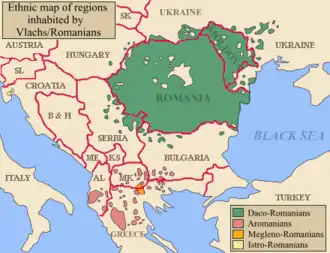 Notable regions with inhabited by Eastern Romance speakers at the beginning of the 21st century
Notable regions with inhabited by Eastern Romance speakers at the beginning of the 21st century.PNG.webp) Map highlighting the three main sub-groups of Daco-Romanians
Map highlighting the three main sub-groups of Daco-Romanians Share of Romanians in Romania (coloured in purple) at commune level (2011 census)
Share of Romanians in Romania (coloured in purple) at commune level (2011 census) Share of Romanian in Romania (coloured in purple) at county level (2011 census)
Share of Romanian in Romania (coloured in purple) at county level (2011 census)
See also
- List of notable Romanians
- Romance languages
- Slavic influence on Romanian
- Legacy of the Roman Empire
- Romanian diaspora
- Romanians in Germany
- Romanian British
- Romanian French
- Romanian Australian
- Romanian American
- Romanian Canadian
- Romanians of Serbia
- Romanians of Ukraine
- Romanians of Hungary
- Romanians of Bulgaria
- History of Romania
- Origin of the Romanians
- Thraco-Roman
- Daco-Roman
- Brodnici
- Morlachs
- Moravian Wallachia
- Culture of Romania
- Art of Romania
- Geography of Romania
- Folklore of Romania
- Music of Romania
- Sport in Romania
- Name of Romania
- Romanian cuisine
- Romanian literature
Notes and references
- "Latina/os". Ethnologue. Retrieved 13 November 2014.
- "Union Latine". Unilat.org. Retrieved 13 November 2014.
- "6–8 Million Romanians live outside Romania's borders". Ziua Veche. Retrieved 13 November 2014.
- "Rezultate definitive ale Recensământului Populaţiei şi al Locuinţelor – 2011 (caracteristici demografice ale populaţiei)" [Final results of Population and Housing Census – 2011 (demographic characteristics of the population)] (PDF) (in Romanian). Romanian Institution of Statistics. 2011. Retrieved 11 April 2015.
- 2014 Moldovan census
- Includes additional 177,635 Moldovans in Transnistria; as per the 2004 census in Transnistria
- "Romeni in Italia - statistiche e distribuzione per regione" (in Italian).
- "Publikation – Bevölkerung – Bevölkerung mit Migrationshintergrund – Ergebnisse des Mikrozensus – Fachserie 1 Reihe 2.2 – 2015 – Statistisches Bundesamt (Destatis)". Destatis.de. Retrieved 11 April 2018.
- "Anzahl der Ausländer in Deutschland nach Herkunftsland in den Jahren 2014 und 2015". Statista.
- "Bevölkerung und Erwerbstätigkeit". Statistisches Bundesamt (Destatis). 2015. p. 62.
- "Población extranjera por Nacionalidad, comunidades, Sexo y Año. Datos provisionales 2020". INE.
- https://as.com/futbol/2019/11/18/seleccion/1574044340_527937.html
- As per the 2001 Ukrainian National Census (data-ro
- "Population of the UK by country of birth and nationality". Office for National Statistics.
- "Câţi români muncesc în străinătate şi unde sunt cei mai mulţi". EWconomica.net. 30 November 2013. Retrieved 11 April 2018.
- "2010 Russia Census". Russian Federation Statistics Office. Archived from the original on 24 April 2012. Retrieved 13 November 2014.
- "Anzahl der Ausländer in Österreich nach den zehn wichtigsten Staatsangehörigkeiten am 1. Januar 2020". Statista.
- V. M. (18 March 2016). "Migratie in cijfers en in rechten 2018" (PDF). HotNews.ro (in Dutch).
- Република Србија: Становништво према националној припадности 2011 [Republic of Serbia: Population by nationality 2011]. Serbian Institute for Statistics (in Serbian). 2011. Archived from the original on 16 April 2013. Retrieved 11 January 2016.
- "Announcement of the demographic and social characteristics of the Resident Population of Greece according to the 2011 Population – Housing Census" (PDF) (Press release). 23 August 2013. Archived from the original (PDF) on 25 December 2013.
- "Bevolking; generatie, geslacht, leeftijd en herkomstgroepering, 1 januari". Centraal Bureau voor de Statistiek (in Dutch).
- Vukovich, Gabriella (2018). Mikrocenzus 2016 – 12. Nemzetiségi adatok [2016 microcensus – 12. Ethnic data] (PDF). Hungarian Central Statistical Office (in Hungarian). Budapest. ISBN 978-963-235-542-9. Retrieved 9 January 2019.
- "População estrangeira com estatuto legal de residente: total e por algumas nacionalidades em território nacional – 2019". Serviço de Estrangeiros e Fronteiras (in Portuguese). July 2020.
- "Immigrants and Descentants, 1 January 2020". Statistics Denmark.
- "Utrikes födda samt födda i Sverige med en eller två utrikes födda föräldrar efter födelseland/ursprungsland, 31 december 2017, totalt". Statistics Sweden / Befolkning efter födelseland, ålder, kön och år. Retrieved 25 February 2020.
- "Census 2016 Summary Results – Part 1" (PDF). Central Statistics Office. 2016.
- "Cyprus 2011 census". Cystat.gov.cy. Retrieved 11 April 2018.
- "Permanent and non permanent resident population by canton, sex, citizenship, country of birth and age, 2014–2015". Federal Statistical Office.
- "Immigrants and Norwegian-born to immigrant parents, 1 January 2019". Statistics Norway.
- Mădălin Danciu (31 December 2018). "Foreigners in the Czechia by citizenship". CZSO.
- "Foreigners by category of residence, sex, and citizenship as at 31 December 2016". Czso.cz. Retrieved 10 January 2018.
- Statistics Finland (20 February 2019). "Statistics Finland's PX-Web databases".
- "Population by nationalities in detail 2011 - 2019". Statistiques // Luxembourg.
- Ambasada României în Polonia. "Comunitatea românească din Polonia". Ambasada României în Republica Polonă (in Romanian).
- Andrei Luca Popescu (21 December 2015). "HARTA românilor plecați în străinătate. Topul țărilor UE în care românii reprezintă cea mai mare comunitate". Gândul (in Romanian).
- "2011 Bulgarian Census". Censusresults.nsi.bg. Archived from the original on 19 December 2015. Retrieved 13 November 2014.
- Ambasada României în Regatul Danemarcei (9 March 2019). "Comunitatea româneacă din Islanda". Ambasada României în Regatul Danemarcei (in Romanian).
- Ministry of Foreign Affairs (Romania). "Bosnia și Herțegovina − Comunitatea românească" (in Romanian).
- "Total ancestry categories tallied for people with one or more ancestry categories reported, 2014 American Community Survey 1-Year Estimates". U.S. Census Bureau. 2014. Archived from the original on 14 February 2020. Retrieved 11 January 2016.
- "U.S. Census Bureau, 2009 American Community Survey". Retrieved 23 December 2011.
- "Romanian-American Community". Romanian-American Network Inc. Retrieved 15 September 2008.
- "2000 Census". Census.gov. Retrieved 2 August 2017.
- Romanian Communities Allocation in United States: Study of Romanian-American population (2002), Romanian-American Network, Inc. Retrieved 14 October 2005. Their figure of 1.2 million includes "200,000–225,000 Romanian Jews", 50,000–60,000 Germans from Romania, etc.
- "2011 National Household Survey: Data tables". 12.statcan.gc.ca. Retrieved 13 November 2014.
- Statistics Canada. "2011 National Household Survey: Data tables". Retrieved 11 February 2014.
- Gabriel Bejan, Petre Bădică (16 February 2008). "200.000 de români trăiesc "visul brazilian"". România liberă.
- "Archived copy". Archived from the original on 21 December 2012. Retrieved 17 August 2012.CS1 maint: archived copy as title (link) Departamentul pentru Românii de Pretutindeni America Latina
- "The Week of the Romanian Diaspora in Argentina – The immigration of the Romanians to Argentina". Imperialtransilvania.com. 6 December 2016. Retrieved 11 April 2018.
- The People of Australia (PDF). Department of Immigration and Border Protection. Australian Government. 2014. ISBN 978-1-920996-23-9. Archived from the original (PDF) on 17 April 2017. Retrieved 28 December 2018.
- "Australia and New Zealand". Romanian Ministry of Foreign Affairs. Archived from the original on 1 August 2012. Retrieved 11 April 2015.
- "Ethnic composition, religion and language skills in the Republic of Kazakhstan". www.stat.kz. 2011. Archived from the original (RAR) on 11 May 2011.
- "Socio-economic development of the Republic of Kazakhstan". stat.gov.kz.
- Pop, Ioan-Aurel (1996). Romanians and Hungarians from the 9th to the 14th century. Romanian Cultural Foundation. ISBN 0880334401.
We could say that contemporary Europe is made up of three large groups of peoples, divided on the criteria of their origin and linguistic affiliation. They are the following: the Romanic or neo-Latin peoples (Italians, Spaniards, Portuguese, French, Romanians, etc.), the Germanic peoples (Germans proper, English, Dutch, Danes, Norwegians, Swedes, Icelanders, etc.), and the Slavic peoples (Russians, Ukrainians, Belorussians, Poles, Czechs, Slovaks, Bulgarians, Serbs, Croats, Slovenians, etc.)
- Minahan, James (2000). One Europe, Many Nations: A Historical Dictionary of European National Groups. Greenwood Publishing Group. p. 548. ISBN 0313309841.
The Romanians are a Latin nation
- Minahan, James (2000). One Europe, Many Nations: A Historical Dictionary of European National Groups. Greenwood Publishing Group. p. 776. ISBN 0313309841.
Romance (Latin) nations... Romanians
- Cole, Jeffrey (2011). Ethnic Groups of Europe: An Encyclopedia. ABC-CLIO. ISBN 978-1598843026.
Romanians are the only Latin people to adopt Orthodoxy
- Ethnic Groups Worldwide: A Ready Reference Handbook By David Levinson, Published 1998 – Greenwood Publishing Group.
- At the time of the 1989 census, Moldova's total population was 4,335,400. The largest nationality in the republic, ethnic Romanians, numbered 2,795,000 persons, accounting for 64.5 percent of the population. Source : U.S. Library of Congress: "however it is one interpretation of census data results. The subject of Moldovan vs Romanian ethnicity touches upon the sensitive topic of" Moldova's national identity, page 108 sqq. Archived 6 October 2006 at the Wayback Machine
- "Comunicat privind identitatea și unitatea istorică și lingvistică a românilor din nordul și sudul Dunării". Romanian Academy. Archived from the original on 31 July 2018. Retrieved 6 January 2019.
- "Romanian Language – Effective Language Learning". Effectivelanguagelearning.com. Retrieved 11 April 2018.
- "Romanian – About World Languages". Aboutworldlanguages.com. Retrieved 11 April 2018.
- Rita J. Markel, The Fall of the Roman Empire, p. 17, Twenty-First Century Books, 2007
- Encyclopædia Britannica, 2009, O.Ed. "The ethnogenesis of the Romanian people was probably completed by the 10th century. The first stage, the Romanization of the Geto-Dacians, had now been followed by the second, the assimilation of the Slavs by the Daco-Romans".
- Varzari, Alexander; Stephan, Wolfgang; Stepanov, Vadim; Raicu, Florina; Cojocaru, Radu; Roschin, Yuri; Glavce, Cristiana; Dergachev, Valentin; Spiridonova, Maria; Schmidt, Horst D.; Weiss, Elisabeth (2007). "Population history of the Dniester–Carpathians: Evidence from Alu markers". Journal of Human Genetics. 52 (4): 308–16. doi:10.1007/s10038-007-0113-x. PMID 17387576.
- Peoples of Europe. Marshall Cavendish Corporation. 2002. p. 408. ISBN 0-7614-7378-5.
vlachs maramures.
- "International Boundary Study Hungary – Romania (Rumania) Boundary" (PDF). 47. US Office of the Geographer Bureau of Intelligence and Research. 15 April 1965. Archived from the original (PDF) on 1 October 2015. Retrieved 10 January 2016. Cite journal requires
|journal=(help) - Hammel, E. A. and Kenneth W. Wachter. "The Slavonian Census of 1698. Part I: Structure and Meaning, European Journal of Population". University of California.
- Трансилванските (седмиградските) българи. Етнос. Език. Етнонимия. Ономастика. Просопографии — Сто години след Любомир Милетич в Седмиградско
- Opreanu 2005, p. 127.
- Spinei 2009, p. 87.
- Плиска-Преслав: Прабългарската култура, Том 2, Българска академия на науките Археологически институт и музей, 1981.
- Stoica, Vasile (1919). The Roumanian Question: The Roumanians and their Lands. Pittsburgh: Pittsburgh Printing Company. p. 18.
- Stoica, Vasile (1919). The Roumanian Question: The Roumanians and their Lands. Pittsburgh: Pittsburgh Printing Company. p. 50.
- Bosch2006, Varzari2006, Varzari 2013, Martinez-Cruz 2012
- Martinez-Cruz B, Ioana M, Calafell F, Arauna LR, Sanz P, Ionescu R, Boengiu S, Kalaydjieva L, Pamjav H, Makukh H, Plantinga T, van der Meer JW, Comas D, Netea MG (2012). Kivisild T (ed.). "Y-chromosome analysis in individuals bearing the Basarab name of the first dynasty of Wallachian kings". PLOS ONE. 7 (7): e41803. Bibcode:2012PLoSO...741803M. doi:10.1371/journal.pone.0041803. PMC 3404992. PMID 22848614.
- Rootsi, Siiri (2004). Human Y-chromosomal variation in European populations (PhD Thesis). Tartu University Press. hdl:10062/1252
- Kushniarevich, A; Utevska, O; Chuhryaeva, M; Agdzhoyan, A; Dibirova, K; Uktveryte, I; Möls, M; Mulahasanovic, L; Pshenichnov, A; Frolova, S; Shanko, A; Metspalu, E; Reidla, M; Tambets, K; Tamm, E; Koshel, S; Zaporozhchenko, V; Atramentova, L; Kučinskas, V; Davydenko, O; Goncharova, O; Evseeva, I; Churnosov, M; Pocheshchova, E; Yunusbayev, B; Khusnutdinova, E; Marjanović, D; Rudan, P; Rootsi, S; et al. (2015). "Genetic Heritage of the Balto-Slavic Speaking Populations: A Synthesis of Autosomal, Mitochondrial and Y-Chromosomal Data". PLOS ONE. 10 (9): e0135820. Bibcode:2015PLoSO..1035820K. doi:10.1371/journal.pone.0135820. PMC 4558026. PMID 26332464.
- "Славяне и субстрат". Vln.by. Retrieved 11 April 2018.
- Underhill, Peter A; Poznik, G David; Rootsi, Siiri; Järve, Mari; Lin, Alice A; Wang, Jianbin; Passarelli, Ben; Kanbar, Jad; Myres, Natalie M; King, Roy J; Di Cristofaro, Julie; Sahakyan, Hovhannes; Behar, Doron M; Kushniarevich, Alena; Šarac, Jelena; Šaric, Tena; Rudan, Pavao; Pathak, Ajai Kumar; Chaubey, Gyaneshwer; Grugni, Viola; Semino, Ornella; Yepiskoposyan, Levon; Bahmanimehr, Ardeshir; Farjadian, Shirin; Balanovsky, Oleg; Khusnutdinova, Elza K; Herrera, Rene J; Chiaroni, Jacques; Bustamante, Carlos D; et al. (2014). "The phylogenetic and geographic structure of Y-chromosome haplogroup R1a". European Journal of Human Genetics. 23 (1): 124–31. doi:10.1038/ejhg.2014.50. PMC 4266736. PMID 24667786.
- Myres, N. M.; Rootsi, S; Lin, A. A.; Järve, M; King, R. J.; Kutuev, I; Cabrera, V. M.; Khusnutdinova, E. K.; Pshenichnov, A; Yunusbayev, B; Balanovsky, O; Balanovska, E; Rudan, P; Baldovic, M; Herrera, R. J.; Chiaroni, J; Di Cristofaro, J; Villems, R; Kivisild, T; Underhill, P. A. (2010). "A major Y-chromosome haplogroup R1b Holocene era founder effect in Central and Western Europe". European Journal of Human Genetics. 19 (1): 95–101. doi:10.1038/ejhg.2010.146. PMC 3039512. PMID 20736979.
- Cruciani, F.; La Fratta, R.; Trombetta, B.; Santolamazza, P.; Sellitto, D.; Colomb, E. B.; Dugoujon, J.-M.; Crivellaro, F.; Benincasa, T.; Pascone, R.; Moral, P.; Watson, E.; Melegh, B.; Barbujani, G.; Fuselli, S.; Vona, G.; Zagradisnik, B.; Assum, G.; Brdicka, R.; Kozlov, A. I.; Efremov, G. D.; Coppa, A.; Novelletto, A.; Scozzari, R. (2007). "Tracing Past Human Male Movements in Northern/Eastern Africa and Western Eurasia: New Clues from Y-Chromosomal Haplogroups E-M78 and J-M12". Molecular Biology and Evolution. 24 (6): 1300–11. doi:10.1093/molbev/msm049. PMID 17351267.
- Stefan; et al. (2001). "Y chromosome analysis reveals a sharp genetic boundary in the Carpathian region" (PDF). European Journal of Human Genetics. 9 (1): 27–33. doi:10.1038/sj.ejhg.5200580. PMID 11175296. S2CID 9057201.
- Cocoş, Relu; Schipor, Sorina; Hervella, Montserrat; Cianga, Petru; Popescu, Roxana; Bănescu, Claudia; Constantinescu, Mihai; Martinescu, Alina; Raicu, Florina (2017). "Genetic affinities among the historical provinces of Romania and Central Europe as revealed by an mtDNA analysis". BMC Genetics. 18 (1): 20. doi:10.1186/s12863-017-0487-5. PMC 5341396. PMID 28270115.
- Dr. Ayfer AKTAŞ, Türk Dili, TDK, 9/2007, s. 484–495, Online: turkoloji.cu.edu.tr
- "31 august - Ziua Limbii Române". Agerpres (in Romanian). 31 August 2020.
- "De ce este sărbătorită Ziua Limbii Române la 31 august". Historia (in Romanian). 31 August 2020.
- Romanian language on Ethnologue.
- "Romanii au nume "trasnite"". Ziua. December 2007. Archived from the original on 6 January 2017. Retrieved 6 December 2007.
- Pop, Ioan-Aurel. "On the Significance of Certain Names: Romanian/Wallachian and Romania/Wallachia" (PDF). Retrieved 18 June 2018.
- In an ever more globalized world the incredibly diverse and widespread phenomenon of migration has played a significant role in the ways in which notions such as "home," "membership" or "national belonging" have constantly been disputed and negotiated in both sending and receiving societies. – Rogers Brubaker, Citizenship and Nationhood (Cambridge: Harvard University Press, 1994).
- "2000 U.S. Census, ancestry responses". US Census Bureau. Archived from the original on 10 February 2020. Retrieved 13 November 2014.
- Marian, Mircea (11 April 2015). "IRES: Aproape 9 din 10 români se consideră religioși, dar doar 10% țin post". Evenimentul Zilei (in Romanian).
- "Religious Belief and National Belonging in Central and Eastern Europe". Pew Research Center's Religion & Public Life Project. 10 May 2017.
- "Orthodox Christianity in the 21st Century". Pew Research Center's Religion & Public Life Project. 10 November 2017.
- "Populația stabilă după religie – județe, municipii, orașe, comune". Institutul Național de Statistică (in Romanian).
- "National Report: Romania – Autumn 2006" (PDF) (in Romanian). European Commission, Eurobarometer. 2006. p. 25. Archived from the original (PDF) on 15 June 2007.
- "Barometrul de Opinie Publică" [Barometer of Public Opinion] (PDF). Open Society Foundation. May 2006. Archived from the original (PDF) on 9 January 2016. Retrieved 8 January 2016.
- "Dumnezeu nu înseamnă același lucru pentru toți românii" (in Romanian). Soros.ro. Archived from the original on 13 July 2014. Retrieved 10 September 2013.
- "Romanians, not superstitious, but believe in miracles". Romania-insider.com. 3 November 2014.
- Bogdan Banu. "Istro-Romanians in Croatia". Istro-romanian.net. Retrieved 13 November 2014.
External links
| Wikimedia Commons has media related to Romanians. |